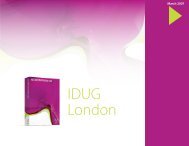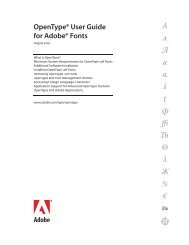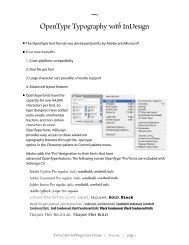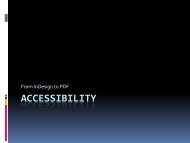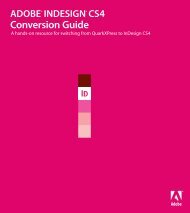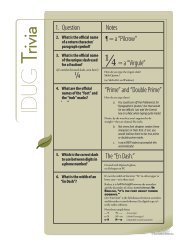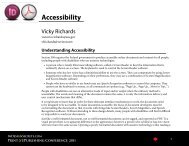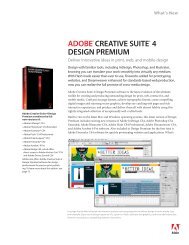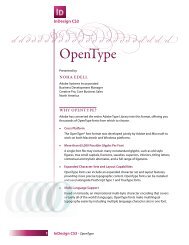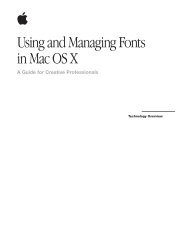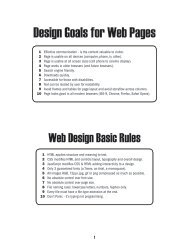Quark to InDesignCS3 Conversion Guide - InDesign User Group
Quark to InDesignCS3 Conversion Guide - InDesign User Group
Quark to InDesignCS3 Conversion Guide - InDesign User Group
You also want an ePaper? Increase the reach of your titles
YUMPU automatically turns print PDFs into web optimized ePapers that Google loves.
tips:<br />
wORkIng wIth fRAmEs<br />
• When you create a frame with the<br />
Rectangle, Ellipse, or Polygon <strong>to</strong>ol, the<br />
default attributes for Stroke and Fill<br />
in the Tools panel are au<strong>to</strong>matically<br />
applied <strong>to</strong> the frame.<br />
• If you select the Rectangle, Ellipse, or<br />
Polygon <strong>to</strong>ol, or the Rectangle Frame,<br />
Ellipse Frame, or Polygon Frame <strong>to</strong>ol,<br />
and then click on a spread or the<br />
pasteboard, a dialog box appears<br />
that lets you enter values for the width<br />
and height of the new object.<br />
• If you double-click the Polygon<br />
Frame <strong>to</strong>ol or the Polygon <strong>to</strong>ol, you<br />
can enter a default setting for the<br />
number of sides and (optionally) a star<br />
inset value.<br />
• If you use the Rectangle, Ellipse, or<br />
Polygon <strong>to</strong>ol (rather than the Frame<br />
<strong>to</strong>ols with the same names), the content<br />
is unassigned.<br />
• You can control the display of frame<br />
edges using the Show/Hide Frame<br />
Edges command (View menu).<br />
Click on a page with the<br />
Polygon <strong>to</strong>ol <strong>to</strong> specify several<br />
attributes of a new polygon.<br />
how do I link text frames?<br />
You won’t find any <strong>to</strong>ols for linking<br />
and unlinking text frames in the<br />
<strong>InDesign</strong> Tools panel. That’s because<br />
linking and unlinking—or threading,<br />
as it’s called in <strong>InDesign</strong>—is accomplished<br />
via the in and out ports on<br />
text frames.<br />
The in port of a text frame is a small<br />
square at the <strong>to</strong>p of the left edge,<br />
just below the upper left corner; the<br />
out port is at the bot<strong>to</strong>m of the right<br />
edge, just above the lower right corner.<br />
If an out port is displayed in red<br />
with a red plus sign within, it indicates<br />
there is overset text.<br />
To add a text frame after an existing<br />
text frame, select the Selection <strong>to</strong>ol<br />
or the Direct Selection <strong>to</strong>ol, click<br />
the existing frame, and then click<br />
the frame’s out port. A loaded icon<br />
is displayed. At this point, you<br />
can click and drag <strong>to</strong> create a new<br />
text frame, or you can click within<br />
another existing text frame. Use the<br />
same process <strong>to</strong> add a text frame in<br />
front of an existing frame, except<br />
begin by clicking the frame’s in port.<br />
To unlink two threaded text frames,<br />
double-click either the out port of<br />
the first frame (that is, the frame<br />
from which the text is threaded)<br />
or double-click the in port of the<br />
second frame (the frame in<strong>to</strong> which<br />
the text is threaded).<br />
how do I design pages with frames?<br />
If you prefer, you can build pages<br />
with <strong>InDesign</strong> as you would with<br />
<strong>Quark</strong>XPress:<br />
• Use the Type <strong>to</strong>ol <strong>to</strong> create rectangular<br />
text frames.<br />
• Use the Frame <strong>to</strong>ols (Rectangle,<br />
Ellipse, and Polygon) <strong>to</strong> create<br />
squares and rectangles, circles and<br />
ovals, and equilateral polygons.<br />
• Use the Pen or Pencil <strong>to</strong>ol <strong>to</strong> create<br />
irregular shapes.<br />
Creating Frames and Objects 29



